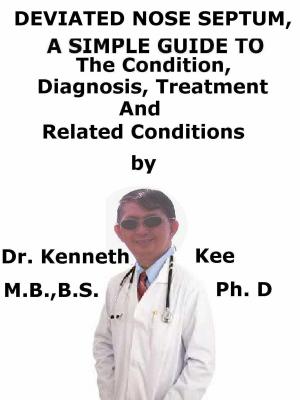Ranula Cyst, (Salivary Cyst) A Simple Guide To The Condition, Diagnosis, Treatment And Related Conditions
Nonfiction, Health & Well Being, Medical, Dentistry, Oral Surgery, Health, Ailments & Diseases, Oral Health| Author: | Kenneth Kee | ISBN: | 9781370844203 |
| Publisher: | Kenneth Kee | Publication: | September 27, 2017 |
| Imprint: | Smashwords Edition | Language: | English |
| Author: | Kenneth Kee |
| ISBN: | 9781370844203 |
| Publisher: | Kenneth Kee |
| Publication: | September 27, 2017 |
| Imprint: | Smashwords Edition |
| Language: | English |
A ranula is a form of mucus cyst found on the floor of the mouth.
Ranulas present as a swelling of connective tissue consisting of collected mucin from a ruptured salivary gland caused by local trauma.
A ranula is a form of mucocele, and could be classified as a disorder of the salivary glands.
Normally a ranula is confined to the floor of the mouth (termed a "simple ranula").
An abnormal variant is the cervical ranula (also called a plunging or diving ranula), where the lump is in the neck rather than the floor of the mouth.
A Ranula is a clear retention cyst in the floor of the mouth occurring from the sublingual salivary glands.
Ranula means a small frog and the cyst is so-called because of a resemblance to a small frog.
The cyst becomes bigger slowly, piercing the deep structures of the floor of the mouth above the mylohyoid muscle.
It is more frequent in neonates and children and potentially can cause respiratory embarrassment.
It appears as a blue-grey, dome-like swelling beneath the tongue. It is highly transluminable.
It may burst spontaneously, discharging its contents and collapsing, but almost invariably recurring.
The clear fluid within a ranula has the viscous, jellylike consistency of egg white.
Ranula cysts are caused by blockage of the salivary glands under the tongue.
Minor damage to the floor of the mouth is believed to injure the delicate ducts that drain saliva from the sublingual gland into the oral cavity.
The lesion is a mucous extra-vasation cyst (mucocele) of the floor of mouth, while a ranula is often larger than other mucoceles (mainly because the overlying mucosa is thicker).
They can grow so large that they fill the mouth.
The most frequent source of the mucin spillage is the sublingual salivary gland, but ranulas may also occur from the sub-mandibular duct or the minor salivary glands in the floor of the mouth.
A cervical ranula happens when the spilled mucin transmits its way through the mylohyoid muscle, which divides the sublingual from the sub-mandibular space, and creates a swelling in the neck.
Symptoms of ranula are:
1.Normally painless swelling on the floor of the mouth below the tongue.
2.Often appears bluish and dome-shaped.
3.If the cyst is large, chewing, swallowing, talking may be affected.
4.If the cyst grows into the neck muscle, breathing can stop.
Diagnostic criteria for a ranula cyst are:
1.Mostly seen in young children and adolescents, both sexes are equally affected.
2.Swelling in floor of mouth, which may be painful.
3.Mostly unilateral, on one side of frenulum.
4.Shape is spherical
5.Size varies from 1 – 5 cm in diameter
6.Color is pale blue with characteristics semi transparent appearance.
7.Surface is smooth and mucous membrane is mobile over the swelling.
Other tests that may be done are:
1.Biopsy
2.Ultrasound
3.CT scan,
The treatment of ranulas normally needs the resection of the sublingual gland.
Surgery may not be required if the ranula is small and asymptomatic.
Marsupialization may occasionally be used, where the intra-oral lesion is opened to the oral cavity with the aim of allowing the sublingual gland to re-establish connection with the oral cavity.
A mucous cyst often can be left by itself as it normally will burst on its own.
If the cyst recurs, it may require to be removed
A ranula is normally removed using laser or surgery.
Treatment is dependent on the size of the ranula.
Small ranulae are excised; larger ones are marsupialized, i.e. de-roofed so that the cyst opens into the floor of the mouth.
The best outcome is removing both the cyst and the gland that caused the cyst.
TABLE OF CONTENT
Introduction
Chapter 1 Ranula Cyst
Chapter 2 Causes
Chapter 3 Symptoms
Chapter 4 Diagnosis
Chapter 5 Treatment
Chapter 6 Prognosis
Chapter 7 Sialolithiasis
Chapter 8 Sialadentitis
Epilogue
A ranula is a form of mucus cyst found on the floor of the mouth.
Ranulas present as a swelling of connective tissue consisting of collected mucin from a ruptured salivary gland caused by local trauma.
A ranula is a form of mucocele, and could be classified as a disorder of the salivary glands.
Normally a ranula is confined to the floor of the mouth (termed a "simple ranula").
An abnormal variant is the cervical ranula (also called a plunging or diving ranula), where the lump is in the neck rather than the floor of the mouth.
A Ranula is a clear retention cyst in the floor of the mouth occurring from the sublingual salivary glands.
Ranula means a small frog and the cyst is so-called because of a resemblance to a small frog.
The cyst becomes bigger slowly, piercing the deep structures of the floor of the mouth above the mylohyoid muscle.
It is more frequent in neonates and children and potentially can cause respiratory embarrassment.
It appears as a blue-grey, dome-like swelling beneath the tongue. It is highly transluminable.
It may burst spontaneously, discharging its contents and collapsing, but almost invariably recurring.
The clear fluid within a ranula has the viscous, jellylike consistency of egg white.
Ranula cysts are caused by blockage of the salivary glands under the tongue.
Minor damage to the floor of the mouth is believed to injure the delicate ducts that drain saliva from the sublingual gland into the oral cavity.
The lesion is a mucous extra-vasation cyst (mucocele) of the floor of mouth, while a ranula is often larger than other mucoceles (mainly because the overlying mucosa is thicker).
They can grow so large that they fill the mouth.
The most frequent source of the mucin spillage is the sublingual salivary gland, but ranulas may also occur from the sub-mandibular duct or the minor salivary glands in the floor of the mouth.
A cervical ranula happens when the spilled mucin transmits its way through the mylohyoid muscle, which divides the sublingual from the sub-mandibular space, and creates a swelling in the neck.
Symptoms of ranula are:
1.Normally painless swelling on the floor of the mouth below the tongue.
2.Often appears bluish and dome-shaped.
3.If the cyst is large, chewing, swallowing, talking may be affected.
4.If the cyst grows into the neck muscle, breathing can stop.
Diagnostic criteria for a ranula cyst are:
1.Mostly seen in young children and adolescents, both sexes are equally affected.
2.Swelling in floor of mouth, which may be painful.
3.Mostly unilateral, on one side of frenulum.
4.Shape is spherical
5.Size varies from 1 – 5 cm in diameter
6.Color is pale blue with characteristics semi transparent appearance.
7.Surface is smooth and mucous membrane is mobile over the swelling.
Other tests that may be done are:
1.Biopsy
2.Ultrasound
3.CT scan,
The treatment of ranulas normally needs the resection of the sublingual gland.
Surgery may not be required if the ranula is small and asymptomatic.
Marsupialization may occasionally be used, where the intra-oral lesion is opened to the oral cavity with the aim of allowing the sublingual gland to re-establish connection with the oral cavity.
A mucous cyst often can be left by itself as it normally will burst on its own.
If the cyst recurs, it may require to be removed
A ranula is normally removed using laser or surgery.
Treatment is dependent on the size of the ranula.
Small ranulae are excised; larger ones are marsupialized, i.e. de-roofed so that the cyst opens into the floor of the mouth.
The best outcome is removing both the cyst and the gland that caused the cyst.
TABLE OF CONTENT
Introduction
Chapter 1 Ranula Cyst
Chapter 2 Causes
Chapter 3 Symptoms
Chapter 4 Diagnosis
Chapter 5 Treatment
Chapter 6 Prognosis
Chapter 7 Sialolithiasis
Chapter 8 Sialadentitis
Epilogue















